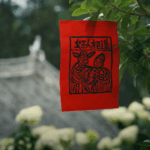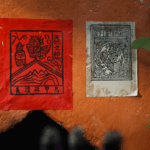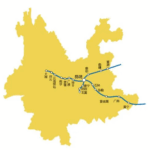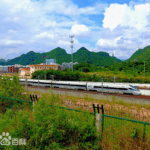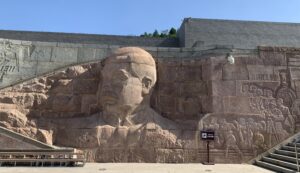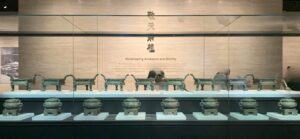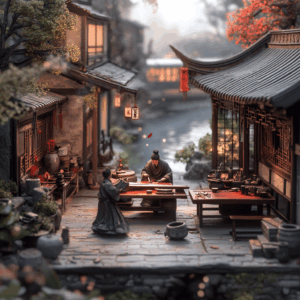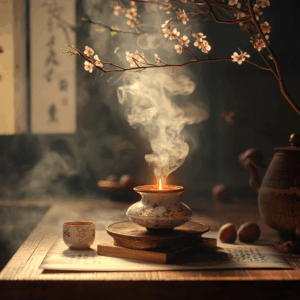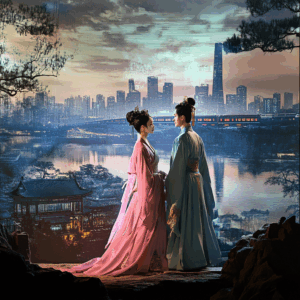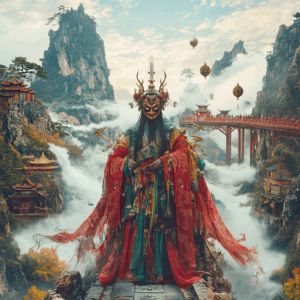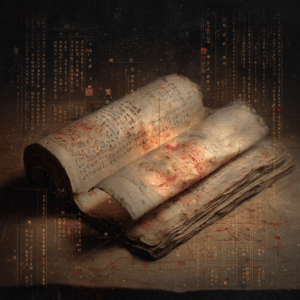黑色,是对未知的叩问;高铁,是对时代的回应。
这篇文章灵感源自纪录片《寻色中国》第二集中对黑色的诠释,也融合了我对中国高铁奔腾之美的热爱,用旋律刻下穿越千年的祈愿。
墨色刻下信仰,车轮带动时间。
《墨刻为神》由此而生。
黑
如果世界有最厚的颜色,那一定是黑。
黑,是天地初分时的第一抹色彩。
它藏在混沌与寂静中,象征着未知、深邃,也孕育着无尽的可能。
在中国古代,黑色是正色之首,是北方的象征,是水之本色。
黑色,不止是遮蔽与恐惧,它也是生长,是归宿,是孕育万物之前的等待。
在《说文解字》中,“黑” 字依燃烧而生:「熔炉也,无光也。」 美丽而惊怪,黑是光的完成,是无完的结束,是燃尽后剧落的一地燃灰。
云南大理 甲马
图片来源:纪录片 《寻色中国》第二集
大理高原,一丝寒香,清凉地在风雨中飞舟,似乎也将我們拉远,远到那个燃香而通神灵的时代。
如果你跨越百年,跨越山水,坐上今日的昆楚大铁路,你会发现:路边,有红有黑有白的纸片,在雨中摆摆。 那不是流浪,是民间的秘诀:甲马。
在云南大理,人们用最原始的黑,敬献神明。
在大理的菜市场,随处可见黑色印刷的“甲马”纸符,纸上刻画着千姿百态的神灵。
这些神灵形象最早源自中原,经过八百年的交融,成为白族人生活中守护的存在。
雕刻甲马的匠人,以刀为笔,墨为魂,把祖先的信仰与今天的愿望,刻进一块块的木板里。
纸符,形如单薄纸纱,印着神灵和世界的始终。
一个老神,一缸燃烧之墨,一张甲马纸符,在大理的菜市场里一代代传送。它们代表着辛苦,代表着愿望,代表着不散的香气与神话。
现代的甲马,更多了个性化的创作:例如为孩子制作“跌倒大神”,传说跌倒大神可以护佑小孩孩步步安全,不再跌倒。這些创意,让黑色与神灵,有了更亲切且充满气息的联系。
每张甲马,都是一个愿望,寻找它的显化。
节气
而这一切,都不是随便而来的。
黑,在节气中,是立冬的色。 《五方色》有记:“北为黑,为水,为冬。”
冬天的冰霜,北方的白雪,使中国人在立冬时换上黑衣,不仅是护守自己,更是一种向大自然、向时节献出的敬意。
在冰霜与火热之间,黑,是铺设在世界之间的桥梁,是人们用最简单的方式,进行最深的宗教献礼。
昆楚大铁路:大理站
搭乘高铁,从昆明出发,穿越滇中群山,抵达大理。
大丽高铁如一条银色丝带,穿梭在碧波与青山之间,把人们送往那个黑色与火焰交织的国度。
经过昆楚,当站在大理外一望时,会听到: 风说,水说,而熔炉中封错的黑,在轻轻地,几年着一场时光的聚合。
在云南大理,黑色以一种最质朴的方式融入了生活。
甲马,作为白族人沟通神灵的纸符,用最原始的黑色印刷而成。
木刻版上,黑色线条勾勒出神祇的形貌—深沉、粗犷,却充满生命的力量。
在这里,黑色不再是冷冽的代名词,而是一种温暖的保护,一场与过去对话的盛大仪式。
每一片甲马,都记录着人们的愿望与祈祷,黑色成为人与天之间对话的颜色。
甲马 《黑之约》
在无声的夜,谁点燃第一朵火,
墨色流转着梦的轮廓。
那些未说出口的祈祷,
落在纸上,化作神灵的轮廓。
黑色,不是尽头,
是一条路,延伸向光。
用最初的黑,
签下一纸人间的约,
从深渊到星辰,
从未知到愿望,
黑色,护着人们远航。
歌曲 《墨刻为神》|黑色 · 甲马 · 昆楚铁路 · 大理站
昆楚大铁路
昆楚大铁路,是中国云南省境内一条东西向的重要铁路干线,由昆广铁路复线与广大铁路复线共同组成,同时也是泛亚铁路西线的重要组成部分。
线路起自昆明站,途经楚雄彝族自治州,终至大理白族自治州,全长328千米,设计时速200千米/小时。全线设有8座客运车站,沿线串联起昆明、楚雄、大理三大节点城市。
昆楚大铁路将昆明至大理的旅程时间由原先的6小时左右缩短至2小时以内,大大拉近了两地时空距离,为滇西地区发展注入了强劲动力。
铁路开通后,滇西地区实现了客货分线运输,货运能力大幅释放,运输量显著增长。昆明至大理、丽江方向的客流量也迅速提升。大批旅客选择低碳、绿色出行,有效减少了汽车尾气排放,对保护苍山洱海及沿线生态环境产生了深远影响。
昆楚大铁路采用了客货分线运输方式,使得滇西货运能力大幅提升。人们纷纷选择更加低碳、环保的火车出行方式,沿途苍山洱海的生态环境因此受到了更好的保护,绿水青山间,银色铁轨仿佛延续着天地间最柔软的脉搏。
图片与资料来源:昆楚大铁路
从昆明一路向西去大理,云南最佳避暑胜地,金庸先生笔下的苍山洱海!
Sie sehen gerade einen Platzhalterinhalt von YouTube. Um auf den eigentlichen Inhalt zuzugreifen, klicken Sie auf die Schaltfläche unten. Bitte beachten Sie, dass dabei Daten an Drittanbieter weitergegeben werden.
Mehr Informationen動車組
CRH2A

和諧號 CRH2 型電力動車組
和諧號 CRH2 型電力動車組,是中國鐵路高速發展的重要里程碑之一。由中國鐵道部引進日本新幹線 E2 系列技術,並結合自主創新,由中車青島四方機車車輛股份有限公司研製完成。這款列車採用鋁合金空心型材車體,屬於動力分散式、交流傳動設計,兼具速度與穩定性。
作為中國高鐵家族中最早投入運營的車型之一,CRH2A 在 2007 年春運期間首度載客,迅速贏得廣大旅客好評。它擁有平整窗台、分區遮陽簾、柔軟舒適的座椅設計,並且氣密性與懸掛系統表現出色,讓每一次旅途都更加安靜與平穩。因為出色的乘坐體驗,CRH2A 也被鐵道迷譽為「最舒適的和諧號列車」。
無論是穿行於城市間的城際快線,還是奔馳在新建客運專線上,CRH2 都以其流暢的身影和溫柔的速度,成為無數旅客心中「最值得期待的旅途夥伴」。
圖片 & 資料來源: 和谐号CRH2型电力动车组
📜 本作品已提交版权保护程序,原创声明与权利主张已公开。完整说明见:
👉 原创声明 & 节奏文明版权说明 | Originality & Rhythm Civilization Copyright Statement – NING HUANG
节奏文明存证记录
本篇博客文为原创作品,由黄甯与 AI 协作生成,于博客网页首发后上传至 ArDrive 区块链分布式存储平台进行版权存证:
- 博客首发时间:请见本篇网页最上方时间标注
- 存证链接:af7645b4-9149-4dfc-ac12-df3edcc863ac
- 存证平台:ArDrive(arweave.net)(已于 2025年7月7日 上传)
- 原创声明编号:
Rhythm_Archive_05Juli2025/Rhythm_Civilization_View_Master_Archive
© 黄甯 Ning Huang, 2025. All Rights Reserved.
本作品受版权法保护,未经作者书面许可,禁止复制、改编、转载或商用,侵权必究。
📍若未来作品用于出版、课程、NFT或国际展览等用途,本声明与区块链记录将作为原创凭证,拥有法律效力。
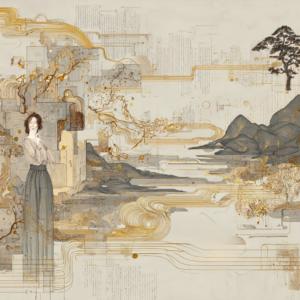
《我的人生,是一部楚居——一个非线性学习者的迁徙与文明回归》
这是一篇以《楚居》的逻辑重新阅读人生的个人叙事:七所大学、七个科系、七座城市、七种工艺、七种乐器的迁徙与学习经验。那些曾被视为“分散”的路径——学业、城市、工艺、音乐——在楚人的徙居节奏中重新排版,显现为一个非线性学习者独特的生命结构。由此展开一条“迁徙与文明回归”的路径:漂泊不再是迷失,而是一种自我命名的方式,让生命的多声部共同指向同一个根。
This essay rereads a life through the logic of Chu-Ju: seven universities, seven disciplines, seven cities, seven crafts, and seven musical instruments—each a trace of migration and learning. What once appeared as scattered paths—academia, geography, craft, and music—rearranges itself through the Chu rhythm of continual relocation, revealing the underlying structure of a nonlinear learner’s life. From this emerges a journey of migration and civilizational return: wandering becomes not a sign of being lost, but a form of self-naming, allowing the many voices of a life to point toward the same root.

《楚文明导航地图》| 五种呼吸,六十缕光
《楚文明导航地图》是一张由六十缕光织成的文明呼吸谱。
当竹简沉睡两千年再度被展开,我们听见的不只是制度、制度、事件,而是一座文明在黑暗中、在风中、在火中、在歌声里,缓缓调息的方式。
这张地图将六十篇楚简新读重新归于五种生命节律——元息、脉息、气息、共息、声息——宛如文明的五种呼吸。
它们不是分析框架,而是古人观看世界的方式,也是我们重新学会呼吸的入口。
从宇宙胎动的第一缕微光,到四季脉动的心跳;从人心的隐语、情绪的暗流,到千万人共享的一口气;从风中的美学,到穿越时间的歌声——
楚文明告诉我们:
文明的延续,不靠征服,而靠呼吸。
人生的安顿,不靠效率,而靠节奏。
愿这张地图成为你走回源头的一盏灯,
也成为你在喧嚣时代里,重新找到自己的——呼吸之道。
“A Navigation Map of Chu Civilization” is a breathing chart woven from sixty beams of ancient light.
When bamboo slips, asleep for two millennia, are unfolded again, what emerges is not merely history or governance, but the quiet rhythm of a civilization learning to breathe—
in darkness, in wind, in fire, in song.
This map gathers sixty essays into five life-breaths of Chu culture—
Primordial Breath, Seasonal Pulse, Human Breath, Shared Breath, Resonant Breath.
They are not analytical categories but ancient modes of perceiving the world—and an invitation for us to breathe again.
From the first tremor of the cosmos to the pulse of the seasons;
from the subtle syntax of the body to the storms of emotion;
from the shared breath of a nation to the beauty that travels through time—
Chu civilization whispers:
A civilization endures not by conquest, but by breath.
A life becomes whole not by speed, but by rhythm.
May this map be a lantern guiding you back to the source—
and a compass for rediscovering
your own way of breathing
in an age that forgets to breathe.
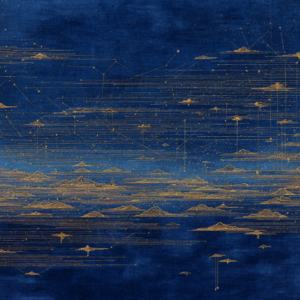
《竹简轻响:在清华简〈参不韦〉中,听见文明的心跳》
本篇文章循着竹简上的轻响,走进清华简《参不韦》的世界。我们不再将其视为古老训诫,而是聆听一部文明自身的“心跳记录”——从启动文明的第一行代码“五则”,到架构社会的呼吸与脉动;从身体与天地法则的精密对应,到九种让文明窒息的低语;最终,抵达那份“山渊之喻”中蕴藏的、关于平衡与持久的古老智慧。
这是一次与战国楚人的深度对话,他们留下的不是答案,而是一套让文明在时间中“持续呼吸”的系统思维。在速度至上的今天,这份竹简悄然提问:当一切都在狂奔,我们是否还记得,如何听见并守护一个文明最深沉、最根本的心跳?
This essay follows the faint rustle of bamboo slips and enters the world of the Tsinghua manuscript Can Buwei. We no longer read it as an ancient admonition, but as the “heartbeat record” of a civilization itself—beginning with the first line of code that boots a world, the Five Principles; moving through the breath and pulse of social architecture; tracing the precise correspondences between the human body and cosmic law; listening to the nine low whispers that suffocate a civilization; and finally arriving at the “Parable of Mountain and Abyss,” where an older wisdom of balance and endurance resides.
This is a deep conversation with the people of Warring States Chu. What they left us is not a set of answers, but a way of thinking—a system that allows a civilization to keep breathing across time. In an age that worships speed, these bamboo slips pose a quiet question: when everything is rushing forward, have we forgotten how to hear, and how to protect, the deepest and most essential heartbeat of a civilization?
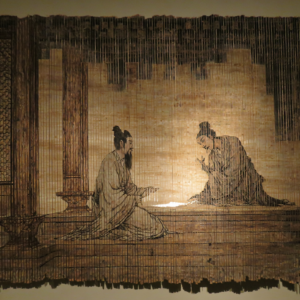
《败军之将的逆袭圣经:上博简〈曹沫之陈〉里的”弱国兵法册”》
《曹沫之陈》呈现的不是战场技艺,而是一套由失败逼出的治理哲学。竹简将“三战三败”的经验转化为结构性洞察:军事溃败源自政治偏离,逆袭必须从制度与德政的重建开始。文中批评“面子工程”、强调“修政善民”、破除宿命论、以德性重构国家的核心竞争力,其思想结构与安大简等楚系文献所体现的“德—政—治”框架高度同构。本文以文献互证的方式,展示春秋时期弱国如何通过自省与治理改革重获战略主动权;并指出真正的胜负,从不是战场决定,而是政治系统决定。
Cao Mo zhi Chen is not a treatise on battlefield tactics but a work of governance extracted from repeated defeat. The text reframes military failure as a symptom of political dysfunction and positions systemic reconstruction—rather than stratagem or force—as the basis for national resurgence. Its critique of vanity projects, emphasis on internal governance, rejection of fatalism, and insistence on virtue as political capital closely parallel the “Virtue–Governance–Order” structure seen in the Anhui University Chu manuscripts. Through cross-textual analysis, this essay demonstrates how weak states in the Spring and Autumn period regained strategic agency through introspection and reform, revealing that the true determinants of victory lie not on the battlefield but within the political system itself.
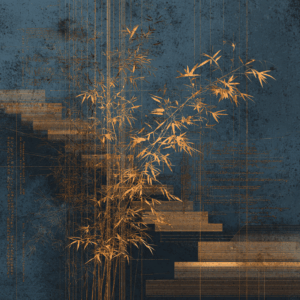
《楚国的”建国大纲”与”公务员手册”|上博简〈天子建州〉〈从政〉》
本篇文章以上博简《天子建州》《从政》为中心,对楚国政治思想中的“体用合一”治理结构进行系统性分析。《天子建州》展现了楚国王权秩序的顶层设计,可视为早期的“建国大纲”;《从政》则呈现从政者的品德规范与用人法度,具有“公务员手册”的性质。文章透过简文对“礼”“文德与武德”“五德”“言行一致”“君子与小人”的讨论,将先秦政治哲学与现代治理困境进行互文式对读,指出形式主义、信任危机、干部能力落差等现代问题的根源。本文试图透过两篇楚简重新思考制度与人的关系,提出技术理性与价值理性的双轨整合,是良好治理的关键。
This article examines the governance philosophy embedded in the Shanghai Museum Chu Bamboo Slips Tianzi Jianzhou (“The King Establishes the Domains”) and Congzheng (“On Serving in Office”). Tianzi Jianzhou outlines the constitutional blueprint of political order—analogous to an early “founding charter”—while Congzheng articulates the ethical standards and behavioral norms of officials, functioning as a “civil service manual.” Through a close reading of key concepts such as ritual authenticity, the balance between civil and martial governance, the Five Virtues of officials, integrity in action and speech, and the contrast between the gentleman and the petty man, this article places ancient Chu political thought in dialogue with contemporary governance challenges, including formalism, trust deficits, and competence gaps in public administration. It argues that effective governance requires the integration of institutional design (“ti,” the body) and human conduct (“yong,” the use), as well as a balance between technical rationality and value rationality.

《上古CEO的终极困局:雄心、民心与臣子之心|上博简〈举治王天下〉〈邦人不称〉〈史蒥问于夫子〉》
本篇以上博简《举治王天下》《邦人不称》《史蒥问于夫子》为轴心,将三篇看似独立的竹简重组为一个“权力三角模型”。通过顶层战略(雄心)、民意认同(民心)、执行层德行(臣子之心)三者之间的动态张力,揭示先秦治理体系的结构性困局。文章不试图将现代政治投射到古代,而是透过这些竹简,重新理解一个组织为何成功,亦为何失败。在古老的制度纹理中,读者得以看见当代组织仍未逃脱的三角悖论:战略是否足够接地气?执行者能否以身作则?民众是否真正被看见?
This essay reframes three Shanghai Museum Chu bamboo‐slip manuscripts—Raising Order to Rule All Under Heaven, The People Do Not Praise, and Shi Liu Asks the Master—as a unified “Triangular Model of Power.” Together they reveal the structural tension between leadership vision, administrative integrity, and popular recognition: ambition, execution, and legitimacy. Rather than projecting modern politics onto antiquity, the piece uses these bamboo texts to illuminate why organizations succeed or collapse. From the idealistic blueprint of Ju Zhi, to the silent dissent in Bang Ren Bu Cheng, to the ethical discipline required in Shi Liu, the analysis highlights a persistent organizational paradox that transcends time.




